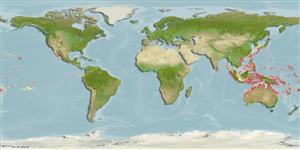>
Blenniiformes (Blennies) >
Tripterygiidae (Triplefin blennies) > Tripterygiinae
Etymology: Enneapterygius: Greek, ennea = nine times + Greek, pterygion = little fin (Ref. 45335).
Environment: milieu / climate zone / depth range / distribution range
Ekologi
laut berasosiasi dengan karang; kisaran kedalaman 0 - 22 m (Ref. 27223). Tropical
Western Central Pacific.
Size / Weight / umur
Maturity: Lm ? range ? - ? cm
Max length : 3.2 cm TL jantan/; (Ref. 90102)
deskripsi pendek
Kunci identifiaksi (pengenalan) | Morfologi | Morfometrik
Duri punggung (Keseluruhan (total)) : 14 - 15; duri punggung lunak (Keseluruhan (total)) : 8 - 10; Duri dubur: 1; Sirip dubur lunak: 17 - 18. Male dark grey with large yellow patch dorsally on head, and lower head and pectoral-fin base black. Female tan with 5 double brown bars on side. Both sexes with black bar at caudal-fin base preceded by white bar/saddle. Dorsal rays III + XI-XII + 8-10; anal rays I,17-18; pectoral rays 14-17; pelvic rays I,2; lateral line interrupted 15-17 + 17-22; head, chest, and pectoral-fin base scaleless; short orbital tentacle present; mandibular pores 3 + 1 + 3. Maximum size to 3.2 cm TL (Ref. 90102).
Adults occur on rocky substrates in association with coral reefs or coral reef lagoons, from shallow areas to the outer reef slope, also in intertidal rock pools (Ref. 13227, 27223). Eggs are hemispherical and covered with numerous sticky threads that anchor them in the algae on the nesting sites (Ref. 240). Larvae are planktonic which occur primarily in shallow, nearshore waters (Ref. 94114).
Springer, V.G. and T.M. Orrell, 1996. Catalog of type specimens of recent fishes in the National Museum of Natural History, Smithsonian Institution, 5: Chaenopsidae, Clinidae, Dactyloscopidae, Labrisomidae, and Tripterygiidae. Smithson. Contrib. Zool. 576:38. (Ref. 13293)
Status IUCN Red List (Ref. 130435)
ancaman kepada manusia
Harmless
penggunaan manusia
Alat, peralatan
laporan khas
muat turun XML
Sumber internet
Estimates based on models
Preferred temperature (Ref.
123201): 24.7 - 29.3, mean 28.5 °C (based on 2149 cells).
Phylogenetic diversity index (Ref.
82804): PD
50 = 0.5000 [Uniqueness, from 0.5 = low to 2.0 = high].
Bayesian length-weight: a=0.00562 (0.00258 - 0.01228), b=3.08 (2.89 - 3.27), in cm total length, based on LWR estimates for this (Sub)family-body shape (Ref.
93245).
Trophic level (Ref.
69278): 3.1 ±0.3 se; based on size and trophs of closest relatives
Daya lenting (Ref.
120179): Tinggi, Waktu penggandaan populasi minimum kurang dari 15 bulan (Preliminary K or Fecundity.).
Fishing Vulnerability (Ref.
59153): Low vulnerability (10 of 100).
Nutrients (Ref.
124155): Calcium = 636 [181, 3,816] mg/100g; Iron = 3.46 [0.93, 9.61] mg/100g; Protein = 18.1 [15.9, 20.2] %; Omega3 = 0.098 [0.016, 0.665] g/100g; Selenium = 104 [12, 665] μg/100g; VitaminA = 23.6 [1.9, 282.4] μg/100g; Zinc = 7.75 [2.73, 17.14] mg/100g (wet weight);
